Application of a Non-carrier-Based Modulation for Current Harmonics Spectrum Control during Regenerative Braking of the Electric Vehicle
Abstract
1. Introduction
2. Methodology
2.1. Simulation Model of the Drive
- is rotor’s impedance,
- is stator’s impedance,
- is additional resistance in rotor replaced by EMF,
- is motor’s phase current.
2.2. Selective Harmonic Elimination
2.3. Laboratory Setup and Measurements
- −
- Driving system built from the Invertec P2 inverter, which drives the first Siemens 1LA7106 motor.
- −
- Breaking system, built of a specially designed laboratory 3-level inverter, which controls the voltage of the second Siemens 1LA7106 motor. The control of transistors, in the case of the Selective Harmonic Elimination (SHE) algorithm, is carried out in the DSPACE 1104 card, using the Look UP tables, created in the MATLAB. The control of transistors, in the case of the Sinus Pulse Width Modulation (SPWM) algorithm, is carried out in the DSPACE 1104 card, using a timer system, created in the MATLAB–Simulink.
3. Current Spectrum Generated by 3-lvl Laboratory Traction Drive
3.1. Regenerative Braking with SPWM
3.2. Regenerative Braking with SHE
4. Results for a 3 kV DC Railway System
4.1. Model Scalling for 3 kV DC
- iln—limits recalculated,
- ilo—original limits,
- nm—number of motors on-board single vehicle,
- ninv—number of inverters on-board single vehicle,
- nv—number of vehicles in the traction set.
4.2. Results of Simulation
4.3. The Influence of a Braking Chopper
- tD—is a time delay of every second pulse,
- T—period of the chopper pulsation.
5. Conclusions
Author Contributions
Funding
Conflicts of Interest
References
- Kleftakis, V.A.; Hatziargyriou, N.D. Optimal control of reversible substations and wayside storage devices for voltage stabilization and energy savings in metro railway networks. IEEE Trans. Transp. Electrif. 2019, 5, 515–523. [Google Scholar] [CrossRef]
- Alfieri, L.; Battistelli, L.; Pagano, M. Impact on railway infrastructure of wayside energy storage systems for regenerative braking management: A case study on a real Italian railway infrastructure. IET Electr. Syst. Transp. 2019, 9, 140–149. [Google Scholar] [CrossRef]
- Aguado, J.A.; Racero, A.J.S.; De La Torre, S. Optimal operation of electric railways with renewable energy and electric storage systems. IEEE Trans. Smart Grid 2018, 9, 993–1001. [Google Scholar] [CrossRef]
- Cui, G.; Luo, L.; Liang, C.; Hu, S.; Li, Y.; Cao, Y.; Xie, B.; Xu, J.; Zhang, Z.; Liu, Y.; et al. Supercapacitor Integrated Railway Static Power Conditioner for Regenerative Braking Energy Recycling and Power Quality Improvement of High-Speed Railway System. IEEE Trans. Transp. Electrif. 2019, 5, 702–714. [Google Scholar] [CrossRef]
- Jiang, Y.; Liu, J.; Tian, W.; Shahidehpour, M.; Krishnamurthy, M. Energy Harvesting for the Electrification of Railway Stations: Getting a charge from the regenerative braking of trains. IEEE Electrif. Mag. 2014, 2, 39–48. [Google Scholar] [CrossRef]
- De La Torre, S.; Sánchez-Racero, A.J.; Aguado, J.A.; Reyes, M.; Martínez, O. Optimal Sizing of Energy Storage for Regenerative Braking in Electric Railway Systems. IEEE Trans. Power Syst. 2015, 30, 1492–1500. [Google Scholar] [CrossRef]
- Radu, P.V.; Szelag, A.; Steczek, M. On-Board Energy Storage Devices with Supercapacitors for Metro Trains—Case Study Analysis of Application Effectiveness. Energies 2019, 12, 1291. [Google Scholar] [CrossRef]
- Jefimowski, W.; Nikitenko, A.; Drążek, Z.; Wieczorek, M. Stationary supercapacitor energy storage operation algorithm based on neural network learning system. Bull. Pol. Acad. Sci. Tech. Sci. 2020, 68. [Google Scholar] [CrossRef]
- Jabr, R.A.; Džafić, I. Solution of DC railway traction power flow systems including limited network receptivity. IEEE Trans. Power Syst. 2018, 33, 962–969. [Google Scholar] [CrossRef]
- Zhang, G.; Tian, Z.; Tricoli, P.; Hillmansen, S.; Wang, Y.; Liu, Z. Inverter Operating Characteristics Optimization for DC Traction Power Supply Systems. IEEE Trans. Veh. Technol. 2019, 68, 3400–3410. [Google Scholar] [CrossRef]
- Jefimowski, W.; Szeląg, A. The multi-criteria optimization method for implementation of a regenerative inverter in a 3 kV DC traction system. Electr. Power Syst. Res. 2018, 161, 61–73. [Google Scholar] [CrossRef]
- Domínguez, M.; Fernández-Cardador, A.; Cucala, A.P. Pecharromán RR. Energy savings in metropolitan railway substations through regenerative energy recovery and optimal design of ATO speed profiles. IEEE Trans. Autom. Sci. Eng. 2012, 9, 496–504. [Google Scholar] [CrossRef]
- Liu, J.; Guo, H.; Yu, Y. Research on the Cooperative Train Control Strategy to Reduce Energy Consumption. IEEE Trans. Intell. Transp. Syst. 2017, 18, 1134–1142. [Google Scholar] [CrossRef]
- Ronanki, D.; Singh, S.A.; Williamson, S.S. Comprehensive Topological Overview of Rolling Stock Architectures and Recent Trends in Electric Railway Traction Systems. IEEE Trans. Transp. Electrif. 2017, 3, 724–738. [Google Scholar] [CrossRef]
- Szelag, A.; Patoka, M. Issues of low frequency electromagnetic disturbances measurements in traction vehicles equipped with power electronics drive systems. Przegląd Elektrotech. 2013, 89, 290–296. [Google Scholar]
- Tao, H.; Hu, H.; Wang, X.; Blaabjerg, F.; He, Z. Impedance-Based Harmonic Instability Assessment in a Multiple Electric Trains and Traction Network Interaction System. IEEE Trans. Ind. Appl. 2018, 54, 5083–5096. [Google Scholar] [CrossRef]
- Mariscottii, A.; Ogunsola, A. Lecture Notes in Electrical Engineering Series: Electromagnetic Compatibility in Railways: Analysis and Management; Springer: Berlin, Germany, 2012. [Google Scholar]
- Hu, H.; Shao, Y.; Tang, L.; Ma, J.; He, Z.; Gao, S. Overview of Harmonic and Resonance in Railway Electrification Systems. IEEE Trans. Ind. Appl. 2018, 54, 5227–5245. [Google Scholar] [CrossRef]
- Baboszin, V.A.; Gavrilovich, B.; Jakovlev, A.A. To the study of analysis on how harmonic radio interference affects the power supply systems of railway transport, Mathematical modeling. Autom. Control Process 2020, 2, 36–45. [Google Scholar]
- Adamski, D.; Ortel, K.; Zawadka, Ł. Unified verification method of electromagnetic compatibility between rolling stock and train detection systems. In Proceedings of the Global Debate on Mobility Challenges for the Future Society, Warsaw, Poland, 15–16 November 2018. [Google Scholar]
- Adamowicz, M.; Szewczyk, J. Research works on new solutions applied in traction drives supplied by 3 kV DC coulud reduce energy losses and EMC problems [SiC-Based Power Electronic Traction Transformer—(PETT) for 3 kV DC Rail Traction]. Energies 2020, 13, 5573. [Google Scholar] [CrossRef]
- Mariscotti, A. Impact of Rail Impedance Intrinsic Variability on Railway System Operation, EMC and Safety. Int. J. Electr. Comput. Eng. 2020, 11, 17–26. [Google Scholar]
- BSI Standards Publication. EN 50238–1:2019, Railway Applications—Compatibility between Rolling Stock and Train Detection Systems; BSI Standards Publication: London, UK, 2019. [Google Scholar]
- Furman, J.; Białoń, A. Influence of Commutation Disturbances on Analysis of Harmonics in Traction Current (In Polish: Wpływ zakłóceń Komutacyjnych na Analizę Harmonicznych w Prądzie Trakcyjnym); Railway Report, No 187; Instytut Kolejnictwa: Warsaw, Poland, 2020. [Google Scholar] [CrossRef]
- Durzyński, Z.; Łatowski, M. PKP requirements on electromagnetic disturbances versus other railway infrastructure operators (In Polish: Wymagania PKP w zakresie zakłóceń elektromagnetycznych na tle innych zarządów kolei). In Proceedings of the Research-Technical Conference—Influence of Electric Traction on Environment, Zakopane, Poland, 14–16 October 1999; pp. 14–16. [Google Scholar]
- Białoń, A. Deriving Limits of Disturbances Parameters for Command, Control and Signaling Systems and Traction Vehicles, Research Work CNTK 6915/23; CNTK: Warsaw, Poland, 1999. [Google Scholar]
- Requirements towards Allowed Limits and Parameters of Disturbances for Devices of Track Occupancy Control on Railway Lines Operated by PKP PLK S.A., Ie-115, Warsaw, Poland. 2015. Available online: https://www.plk-sa.pl/files/public/user_upload/pdf/Akty_prawne_i_przepisy/Instrukcje/Wydruk/Wymagania_Ie_-115_internet.pdf (accessed on 1 November 2020).
- Dahidah, M.S.A.; Konstantinou, G.; Agelidis, V.G. A Review of Multilevel Selective Harmonic Elimination PWM: Formulations, Solving Algorithms, Implementation and Applications. IEEE Trans. Power Electron. 2015, 30, 4091–4106. [Google Scholar] [CrossRef]
- Steczek, M.; Chudzik, P.; Lewandowski, M.; Szeląg, A. PSO-Based Optimization of DC-Link Current Harmonics in Traction VSI for Electric Vehicle. IEEE Trans. Ind. Electron. 2020, 67, 8197–8208. [Google Scholar] [CrossRef]
- Napoles, J.; Leon, J.I.; Portillo, R.; Franquelo, L.G.; Aguirr, M.A. Selective Harmonic Mitigation Technique for High-Power Converters. IEEE Trans. Ind. Electron. 2009, 57, 2315–2323. [Google Scholar] [CrossRef]
- Leon, J.L.; Kouro, S.; Franquelo, L.G.; Rodrigez, J.; Wu, B. The Essential Role and the Continuous Evolution of Modulation Techniques for Voltage-Source Inverters in the Past, Present, and Future Power Electronics. IEEE Trans. Ind. Electron. 2016, 63, 2688–2701. [Google Scholar] [CrossRef]



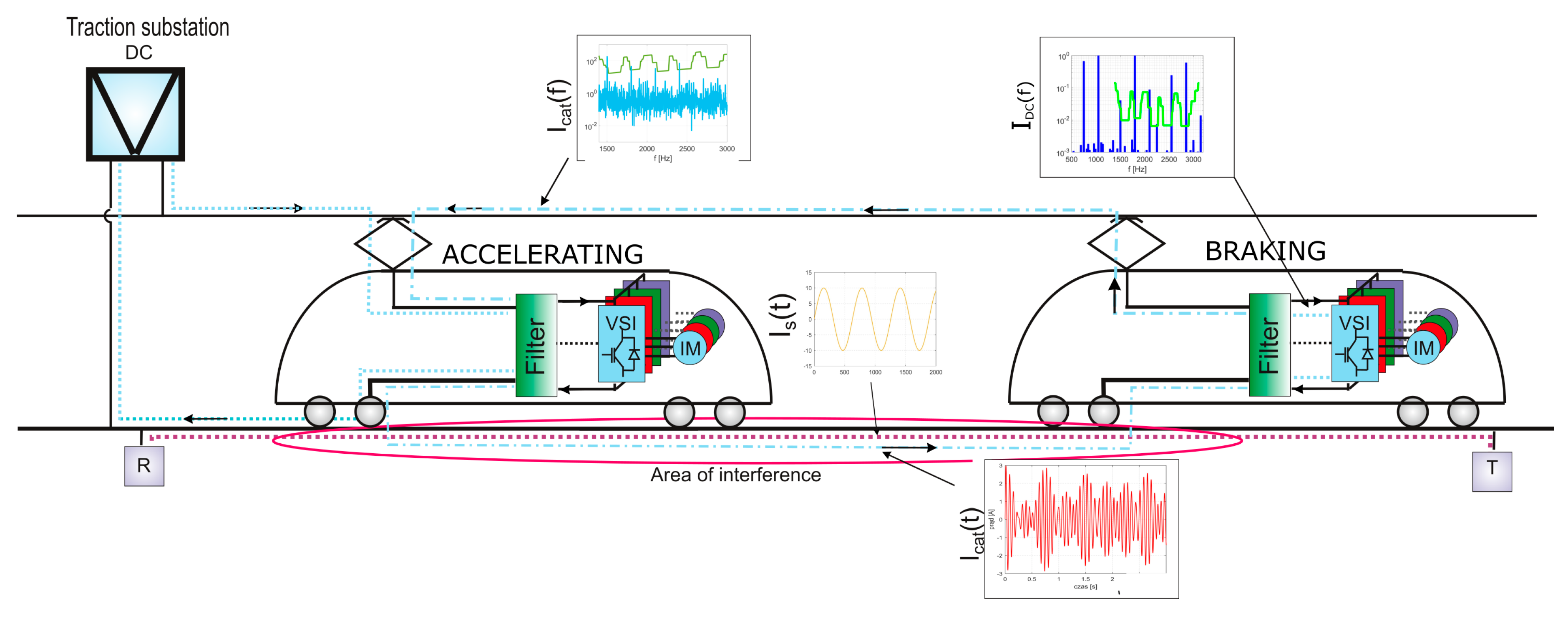


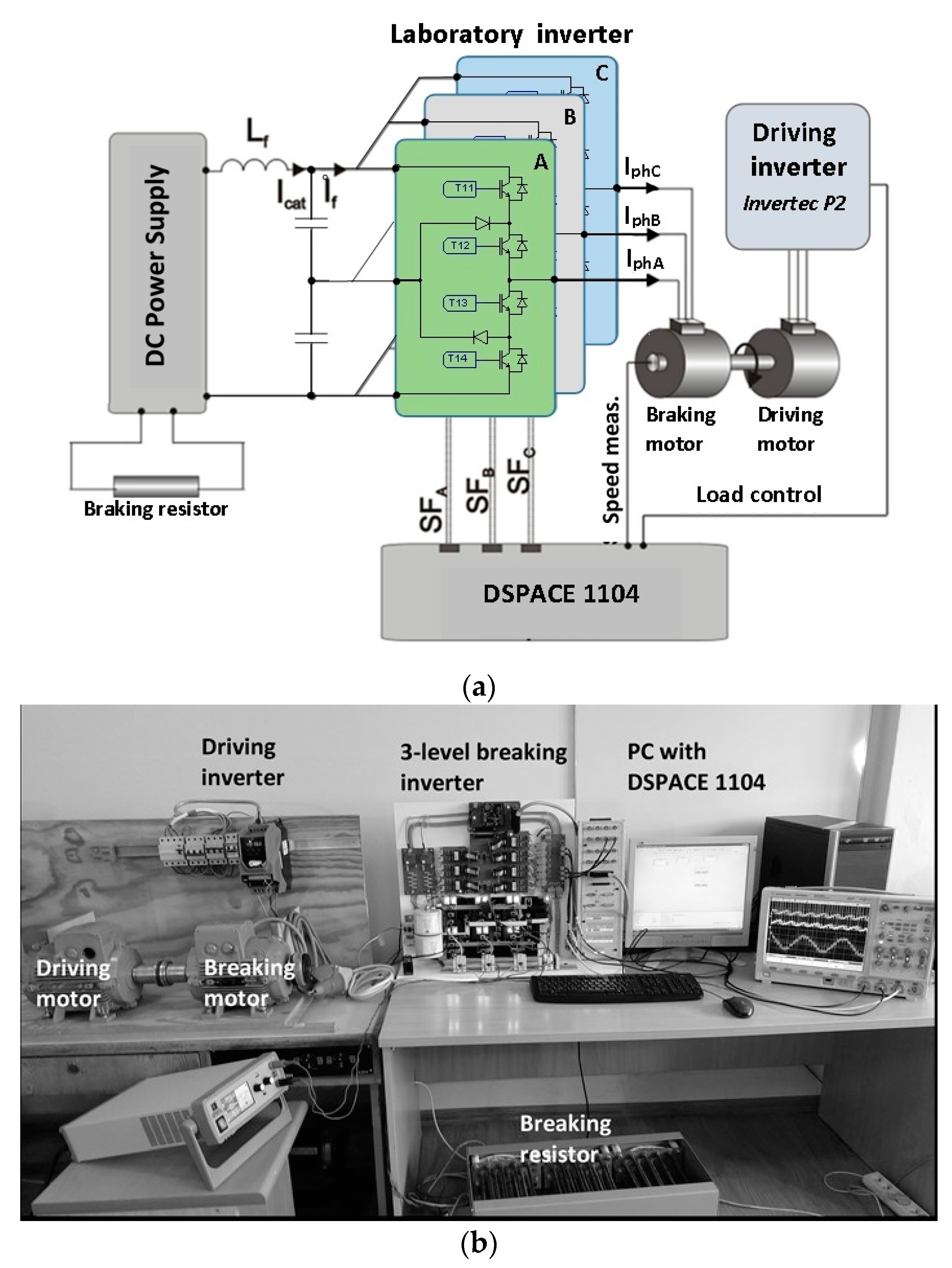
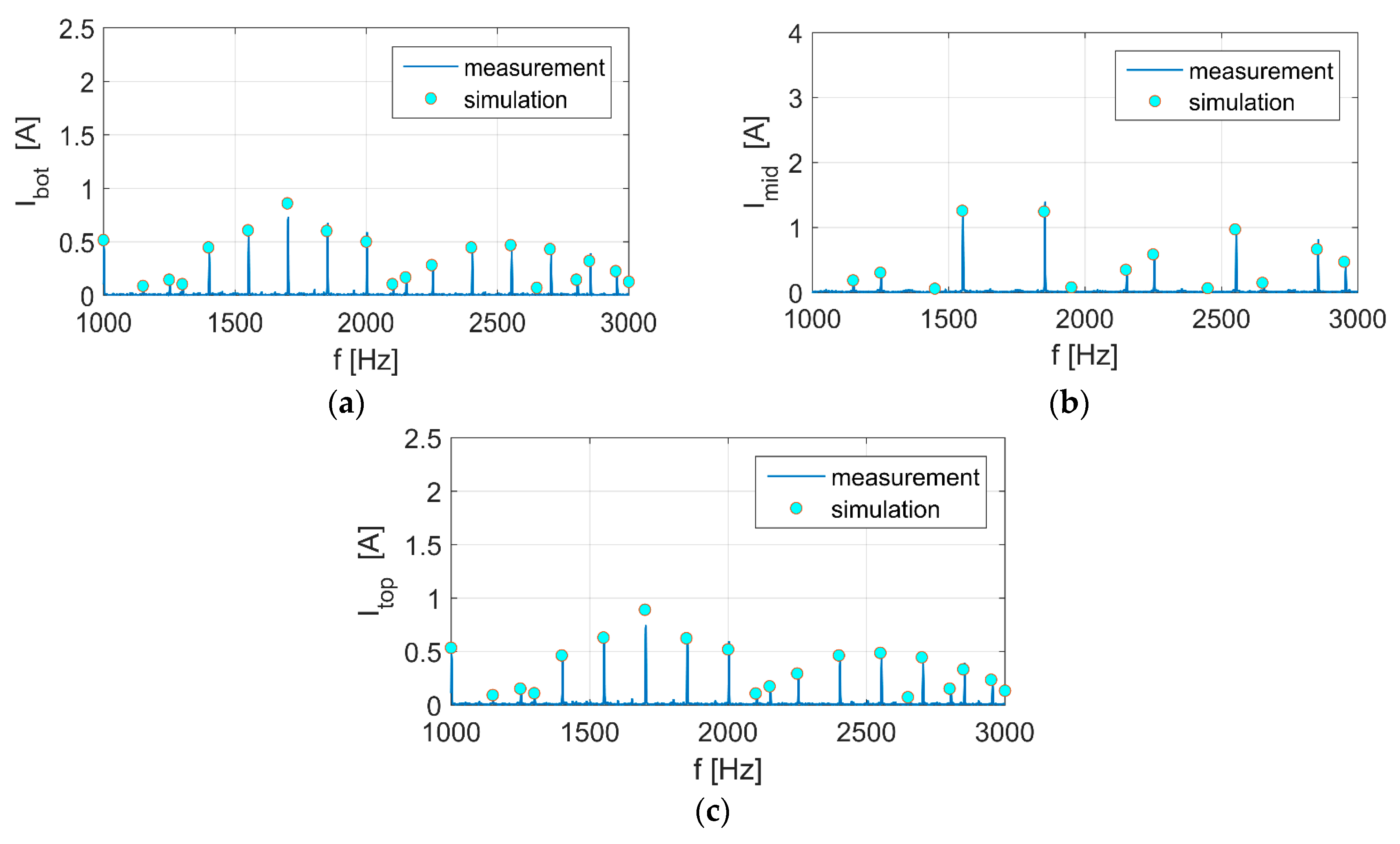

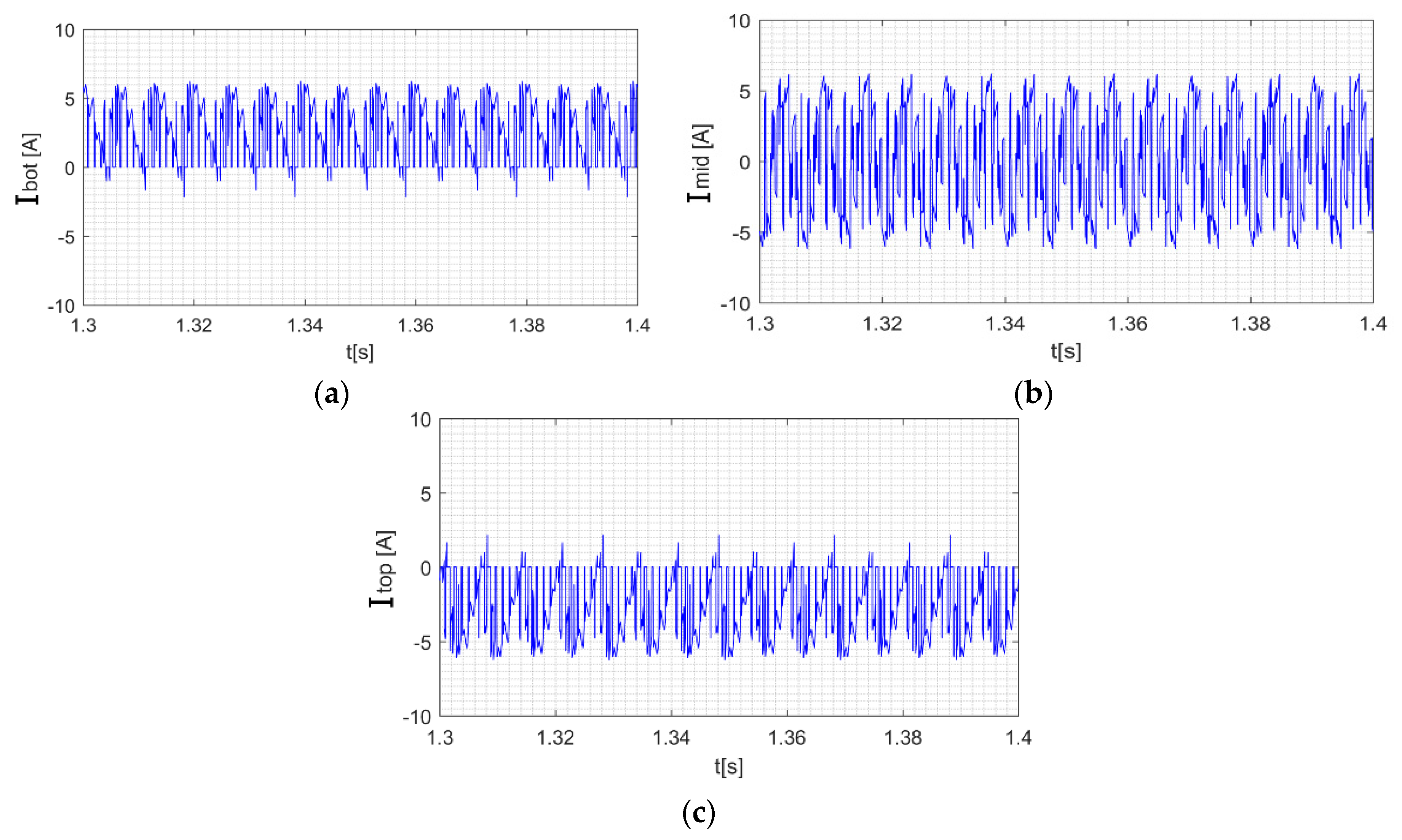







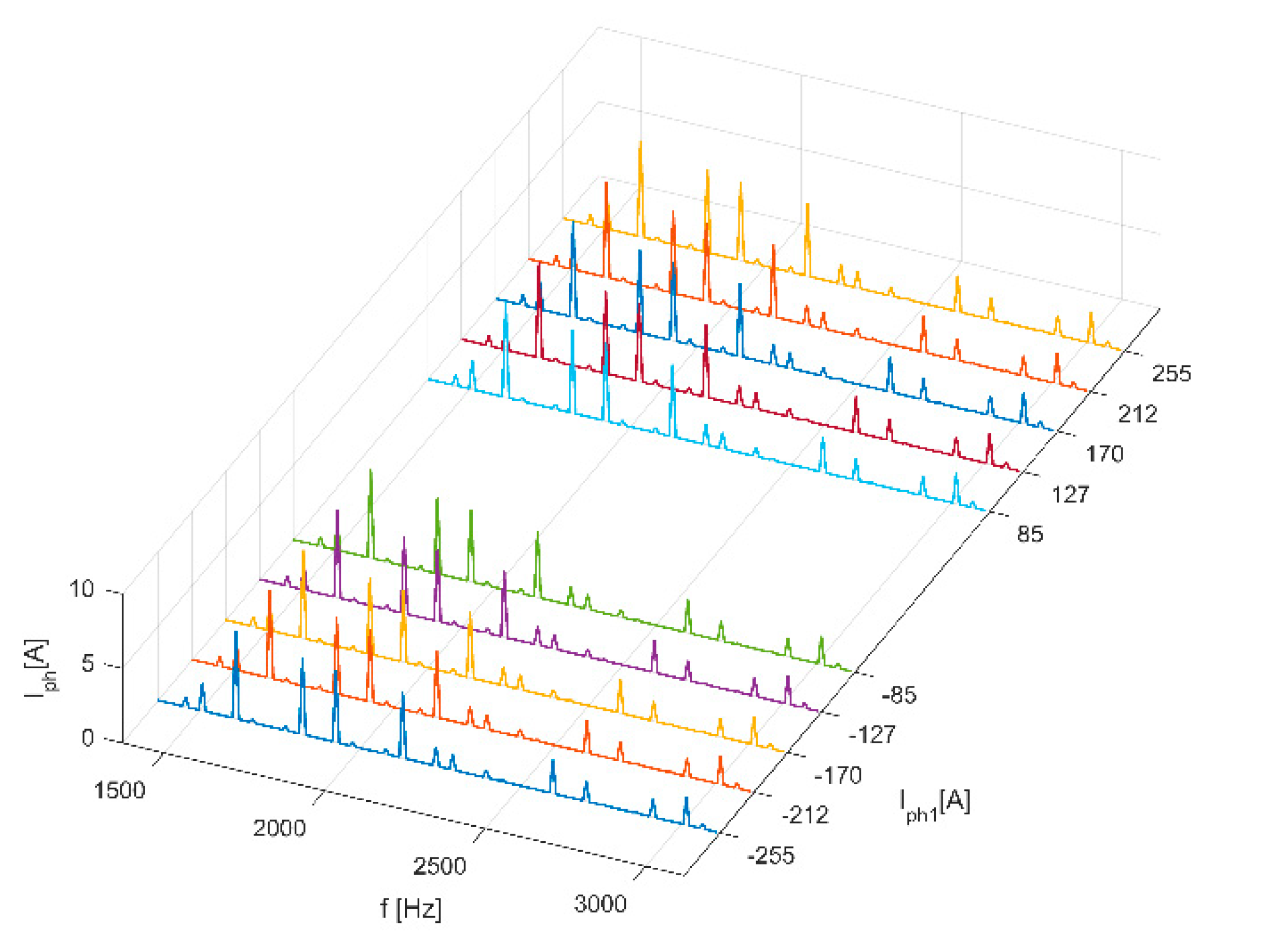
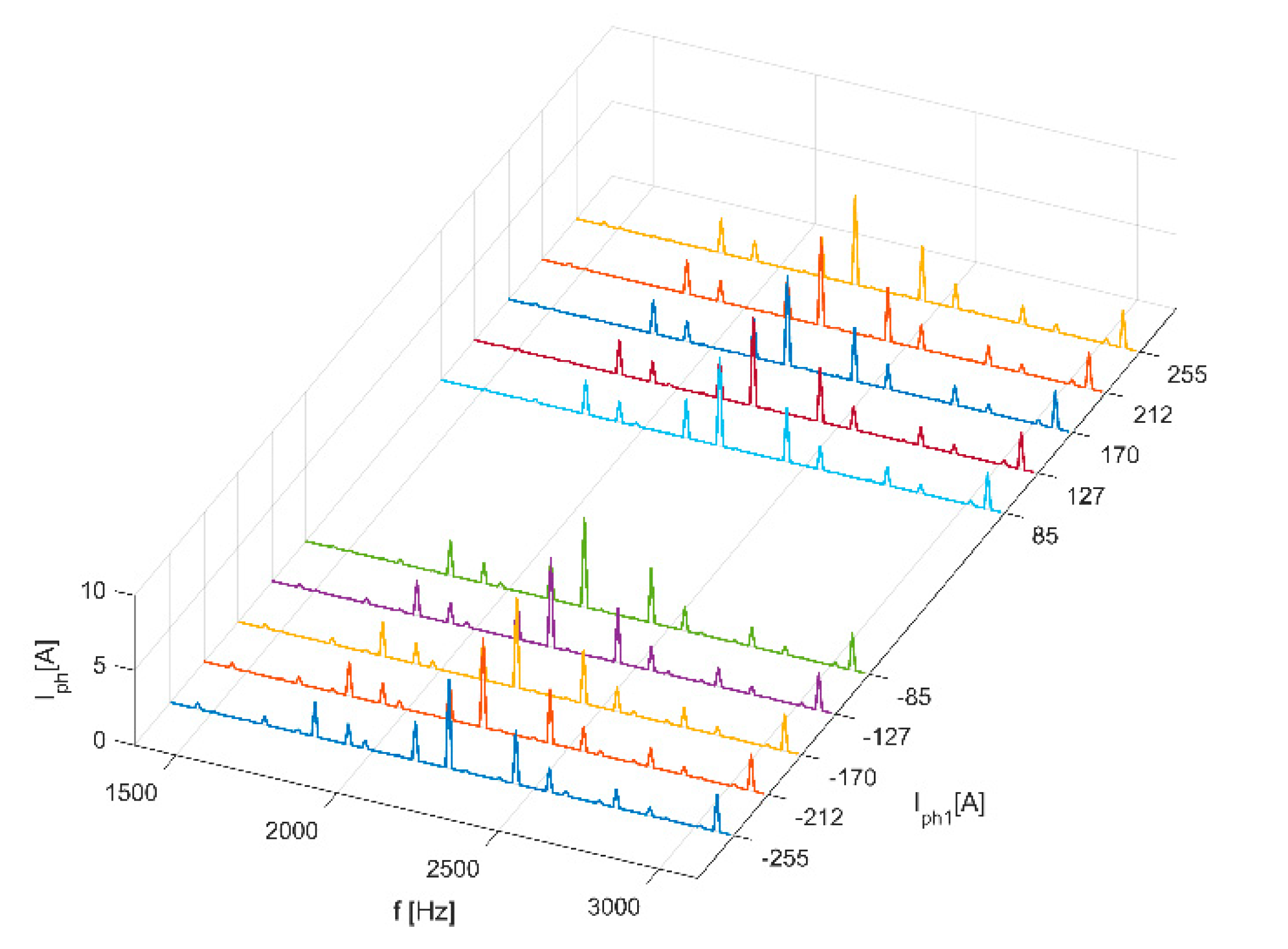
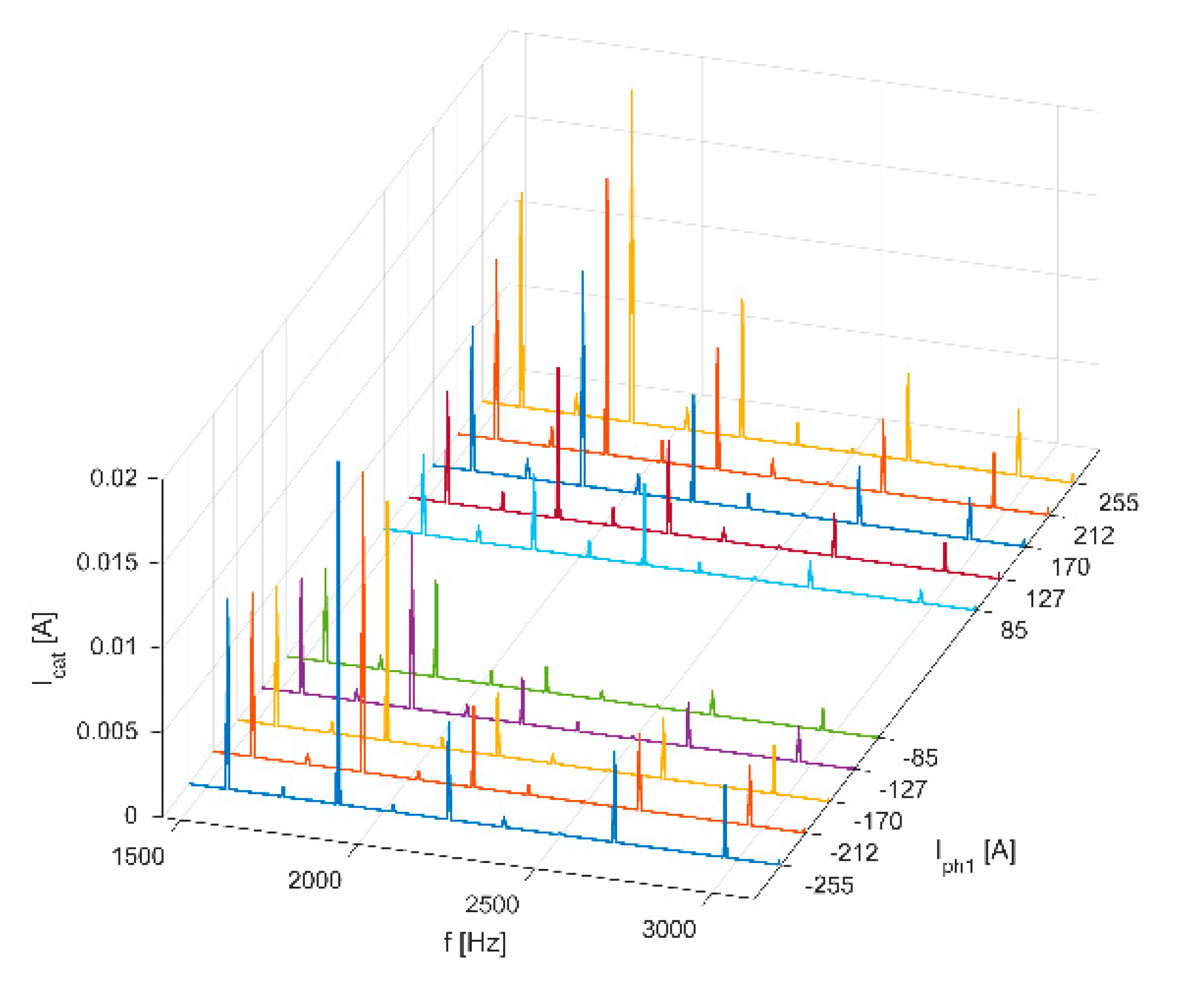


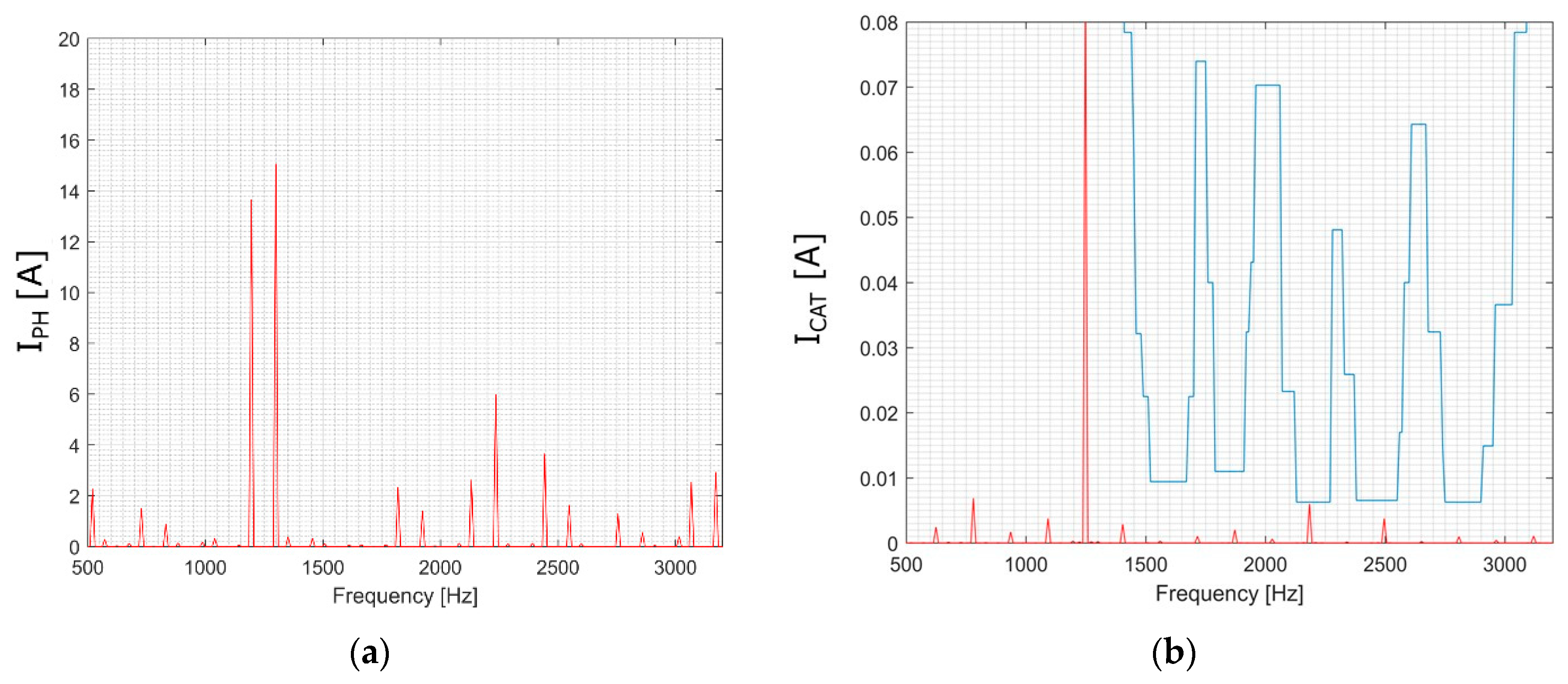

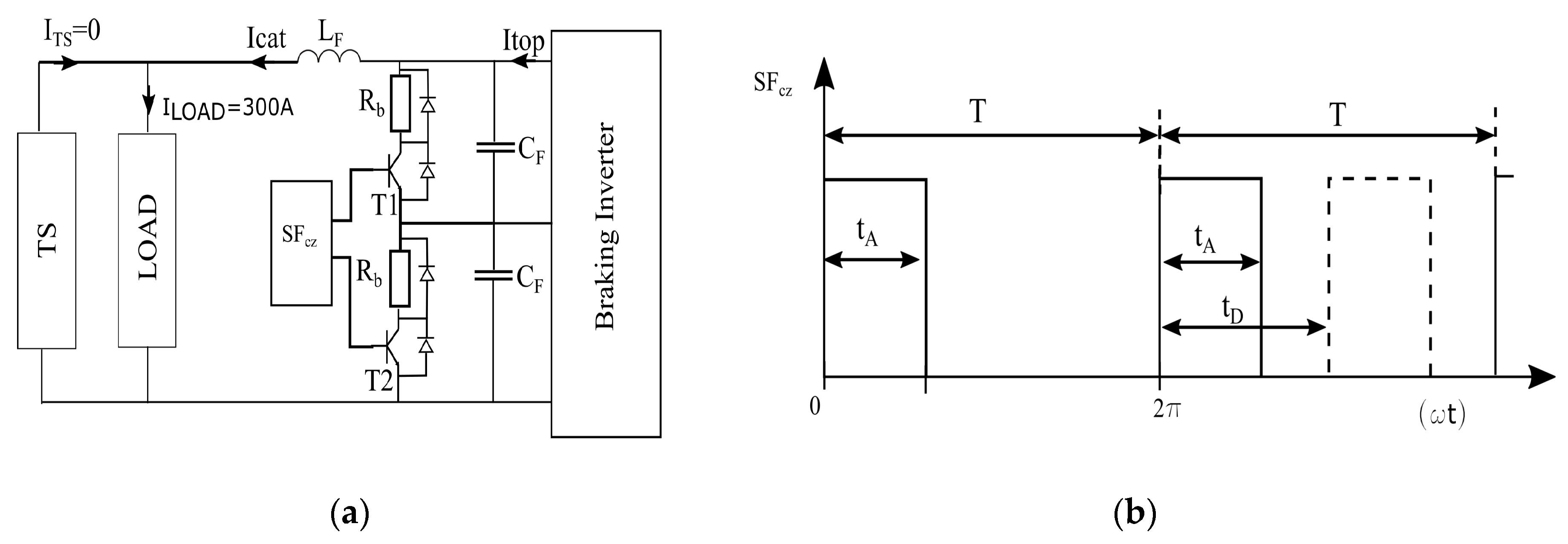

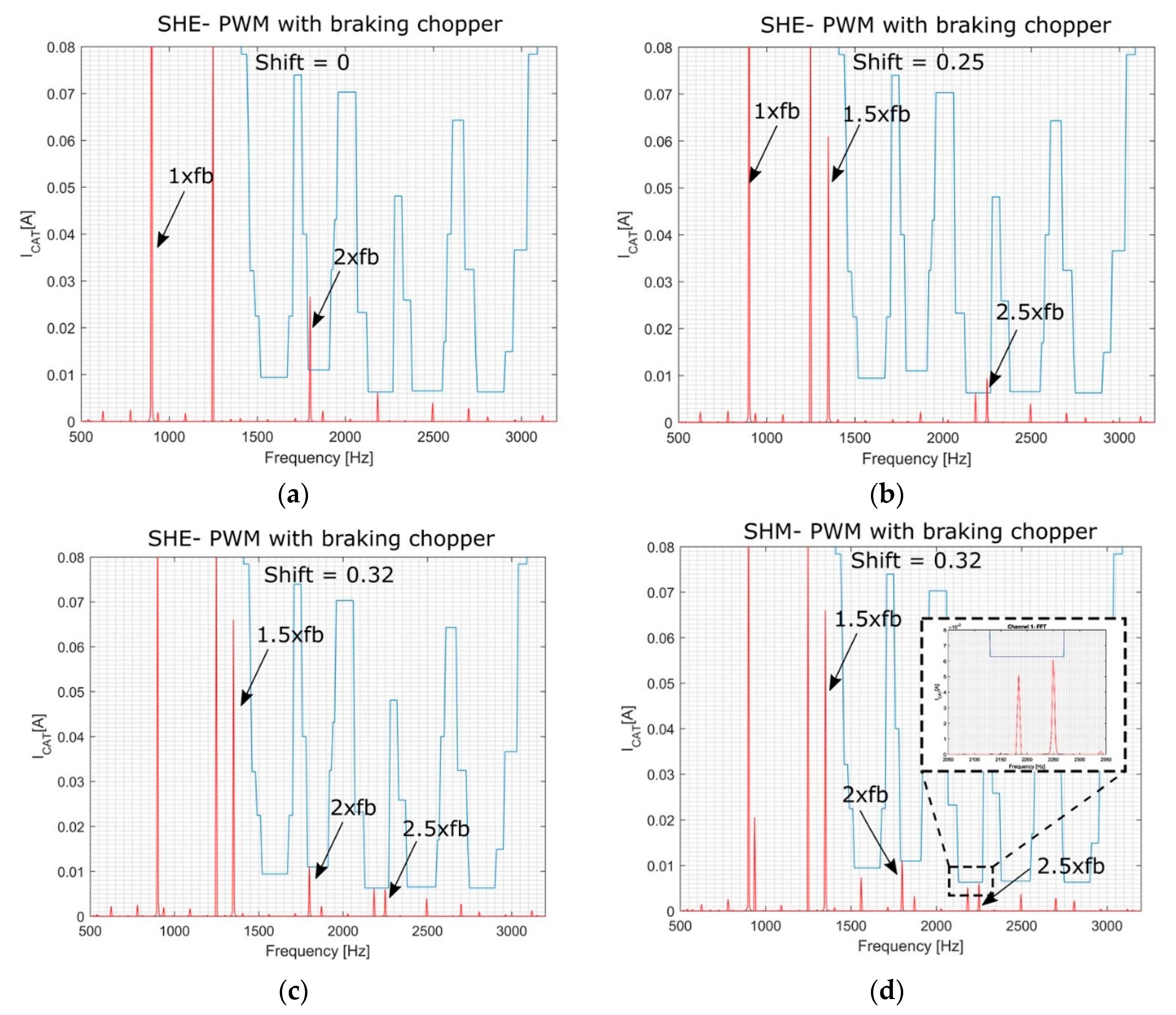

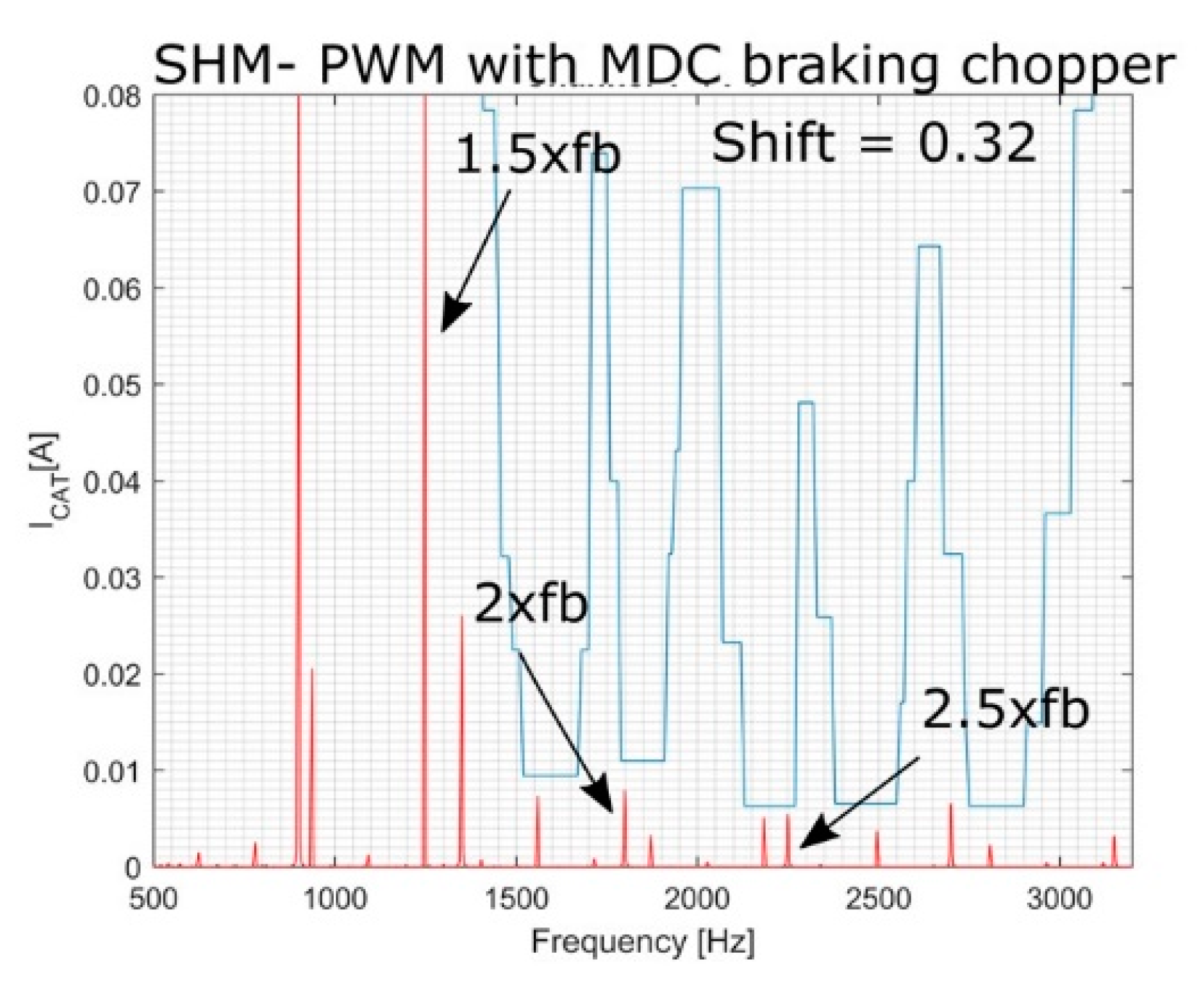
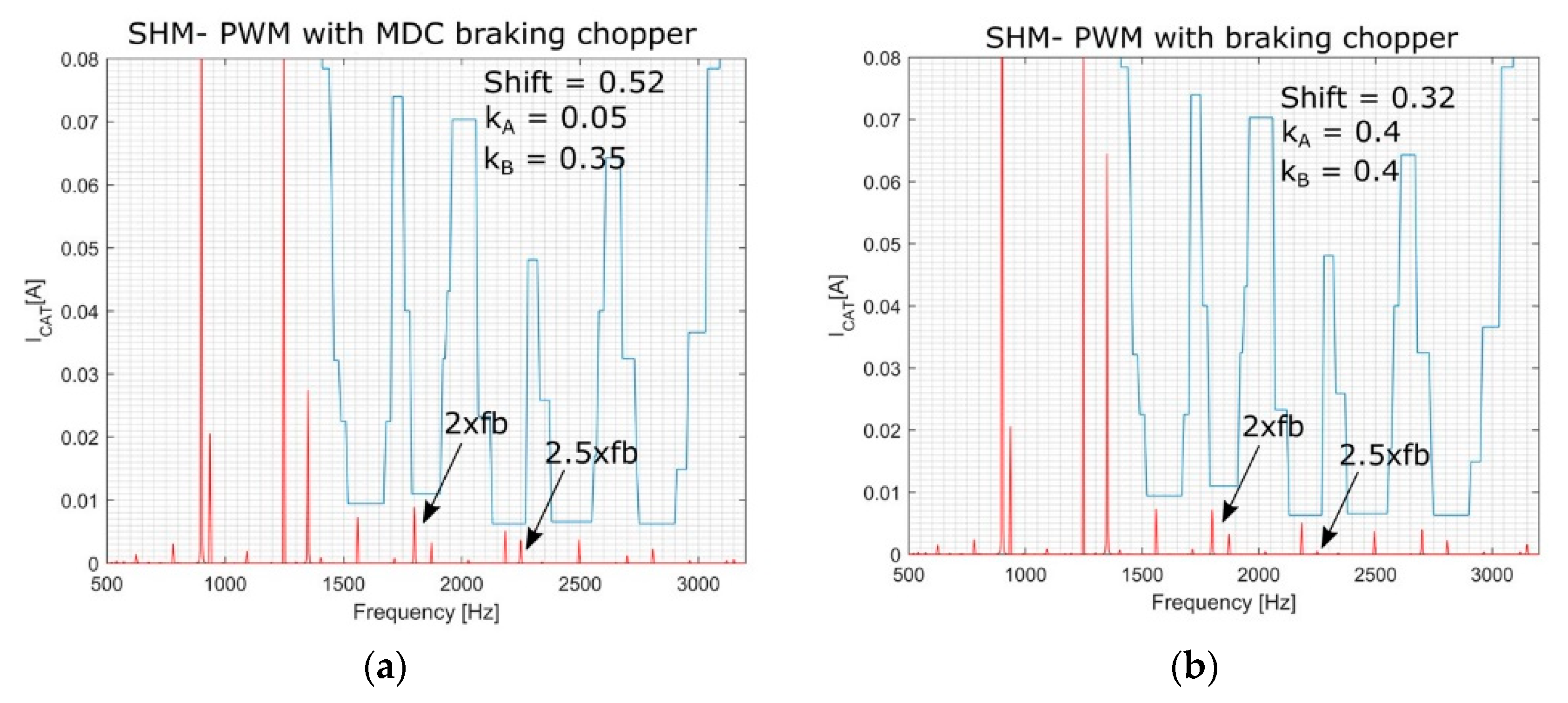

| Type | Siemens 1LA7106 (Motor) | 3KVM (Model) |
|---|---|---|
| Rated power—Pn | 2.2 kW | 500 kW |
| Rated current—In | 4.85 A | 170 A |
| Rated voltage—Un | 400 V | 1900 V |
| Stator leakage inductance per-phase—Ls | 10.8 mH | 1.56 mH |
| Stator winding resistance per phase—Rs | 2.84 Ω | 0.107 Ω |
| Rotor leakage inductance per-phase—L’r | 10.6 mH | 1.6 mH |
| Rotor resistance per phase—R’r | 2.73 Ω | 0.07 Ω |
| Core loss resistance—Rm | 1200 Ω | ∞ |
| Magnetizing inductance—Lm | 275 mH | 53 mH |
Publisher’s Note: MDPI stays neutral with regard to jurisdictional claims in published maps and institutional affiliations. |
© 2020 by the authors. Licensee MDPI, Basel, Switzerland. This article is an open access article distributed under the terms and conditions of the Creative Commons Attribution (CC BY) license (http://creativecommons.org/licenses/by/4.0/).
Share and Cite
Steczek, M.; Chudzik, P.; Szeląg, A. Application of a Non-carrier-Based Modulation for Current Harmonics Spectrum Control during Regenerative Braking of the Electric Vehicle. Energies 2020, 13, 6686. https://doi.org/10.3390/en13246686
Steczek M, Chudzik P, Szeląg A. Application of a Non-carrier-Based Modulation for Current Harmonics Spectrum Control during Regenerative Braking of the Electric Vehicle. Energies. 2020; 13(24):6686. https://doi.org/10.3390/en13246686
Chicago/Turabian StyleSteczek, Marcin, Piotr Chudzik, and Adam Szeląg. 2020. "Application of a Non-carrier-Based Modulation for Current Harmonics Spectrum Control during Regenerative Braking of the Electric Vehicle" Energies 13, no. 24: 6686. https://doi.org/10.3390/en13246686
APA StyleSteczek, M., Chudzik, P., & Szeląg, A. (2020). Application of a Non-carrier-Based Modulation for Current Harmonics Spectrum Control during Regenerative Braking of the Electric Vehicle. Energies, 13(24), 6686. https://doi.org/10.3390/en13246686






